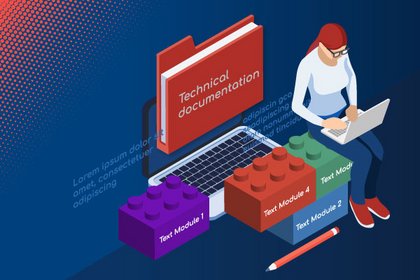Technical Documentation in the Cloud – For Security and Flexibility
There are many reasons why you should consider moving your technical documentation to the cloud. Find out what advantages you’ll enjoy with this solution and what you should look out for when it comes to data security.

The way we work with software is fundamentally changing: instead of installing programs exclusively on local computers, growing numbers of companies are using browser-based applications. Armed with these cloud solutions, teams can work together directly in the browser – negating the need for the time-consuming installation and maintenance of local software on each individual workstation.
This trend towards cloud-based working is now also finding its way into the world of technical documentation, with SCHEMA ST4 from Quanos available as a web application since summer 2024. By combining modern web technologies with the tried and tested performance of the SCHEMA ST4 platform, technical writers can work flexibly in the browser, regardless of their location.
“We are seeing a clear trend towards the cloud. Many companies are looking to move away from installing software in their own IT infrastructure,” explains Jörg Arrenberg, Vice President Development SCHEMA ST4 at Quanos. And there are many reasons in favor of moving technical documentation to the cloud.
Six good reasons for storing technical documentation in the cloud

User-friendliness
Browser-based applications follow modern design standards. The clear structure and well-designed navigation are based on established templates that users are familiar with from their daily work with professional web applications. This means that users of SCHEMA ST4 can focus on the task at hand – creating high-quality technical documentation – while the user interface provides targeted support for their work.

Facilitates remote work
New ways of working are gaining in importance; for many employees, working from home has become a key requirement when considering a (new) job. If the content management system is in the cloud, technical writers can access it from anywhere, be it from home, while away on a workation, or in a co-working space. Of course, this form of working is contingent on connectivity. But there’s no need to worry about long upload and download times – a stable and fast connection (such as that offered by 5G) is all you need in most cases.

Reduces demands on internal IT resources
Setting up software internally and subsequently maintaining it requires human resources in IT. Those who use software-as-a-service have no worries when it comes to installations, back-ups, maintenance, and security measures, because the cloud provider takes care of all these tasks. Using the cloud can also result in a reduced outlay on expensive hardware such as servers and storage.

Around the clock availability
Managing a cloud-based application lies in the hands of specialists for whom the complication-free functionality of your product is a top priority, which guarantees that you as a customer can count on a very high level of software availability. If, in isolated cases, a technical problem does occur then cloud providers like Quanos can resolve it quickly and directly without having to access an external company system.
With local installations, on the other hand, an application is often overshadowed by other company applications and is therefore frequently neglected, which can lead to performance problems or even unexpected failures.

Future-proof networks
Data exchanges between two or more systems are easier if they are all available in the cloud, which is increasingly the case these days. Local applications often require customized programming, which is also costly.

Fewer discussions about the budget
The one-off purchase of a content management system often involves high investment costs in the tens of thousands, which first require internal approval. Added to this come ongoing costs for maintenance contracts. Software-as-a-service, on the other hand, is billed as a subscription, which makes gaining budget approval much easier and conserves liquidity.
A further advantage is the high degree of flexibility – if your requirements change, you can adapt the subscription to your actual needs or cancel it, without having to write off investments made in the past.
Technical documentation in the cloud – what you need to think about
Some companies are reluctant to use a cloud service out of concern that the provider will not adequately protect their data from unauthorized access or due to a worry that it will be stored on servers in other countries. Others fear that they will be unable to access their technical documentation around the clock, for example in the event of technical failures.
If you are careful to consider the following points, these risks can be greatly minimized:
- Choose a software provider that is based in Germany or at least in Europe. This means they are subject to European legislation, including the General Data Protection Regulation (GDPR).
- Make sure that the provider has ISO 27001 certification, a standard for information security. Cloud providers with this certification can demonstrate that they implement the necessary security measures for their customers.
- Ask providers of content management systems for technical writing whether they satisfy all of your data security demands and availability requirements. Your questions should include details such as:
- Where are the data centers that are used to store my data?
- How is my data protected against unauthorized access?
- If a technical failure arises, how quickly will the system with our data be available again? Or how long will it take for us to be able to resume working with our data after a fire in the data center, ransomware attack, or other major technical failure (you’ll soon find out that this is much quicker than if you operate the system internally)?
- What level of availability do you guarantee? What response times can be expected in the event of faults and how can we contact the technical support team?
Quanos operates in the cloud
Quanos customers have a choice:
- To set up the SCHEMA ST4 content management system in their own IT infrastructure or opt for ST4 Web Author and work in the content management system via their browser.
- Are you keen to benefit fully from the advantages offered by software-as-a-service? With ST4 Cloud, you can create and manage your technical documentation exclusively in the cloud and use the full range of functions of our component content management system in your browser.
Both Quanos InfoTwin for networking product documentation, spare parts, and service information, and ST4 AI Jetpack for AI-supported metadata allocation are also cloud-based.


